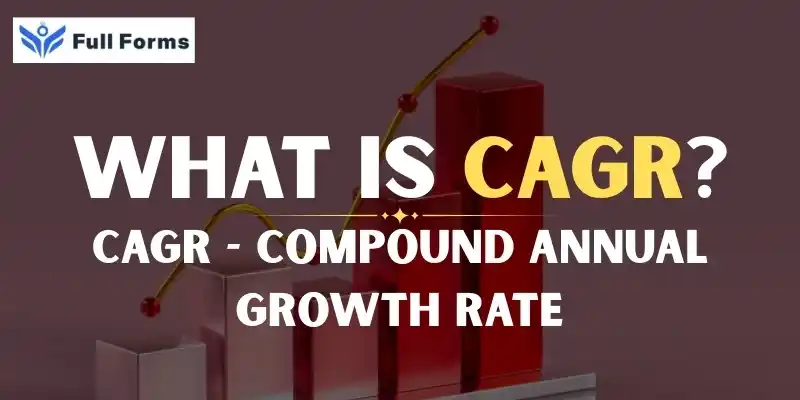Compound Annual Growth Rate
(CAGR)

Description
Get to Know Compound Annual Growth Rate (CAGR): An Easy Guide
You may have heard someone talk about how much his investment has grown, probably dropping the term ‘Compound Annual Growth Rate’ or CAGR. That sounds pretty technical, but it’s actually a very beneficial and easy-to-understand concept if you have an interest in investment, personal finance, or growing a business. Stay with us in this article to find what ‘CAGR’ is, how it is calculated and why it matters.
Compound Annual Growth Rate
It is another way to look at how much something has increased on average each year over a period of time. This could be an investment, sales for a company, or any number that changes over time.
Simple average growth is not the same as CAGR because CAGR takes into account compounding—that is, it looks at not only the growth each year but how this growth stacks on itself year after year. In other words, CAGR gives you the “averaged” annual growth rate if the value were to grow at an annualized constant rate each year.
Why is CAGR Useful?
CAGR is a crucial metric for demonstrating how a business or investment has grown over several years. It filters out all the noise in between to present a very clear picture. It helps to compare different investments or business opportunities on an apples-to-apples basis. For instance, if money has been invested in two different mutual funds for five years, and the returns varied each year in both the funds, after pulling out the actual numbers CAGR would depict which one performed better over time.
[(Ending Value / Beginning Value) ^ (1 / Number of Years)] = CAGR - 1
The aforementioned can be rewritten generally for convenience as follows: Let's say you initially invest ₹10,000 in a mutual fund. After 3 years, the investment stands at ₹15,000. To solve for CAGR:
Beginning Value = ₹10,000
Ending Value = ₹15,000
Number of Years = 3
Substitute these into the formula:
CAGR = [(FV / PV) ^ (1/n)] - 1
CAGR = [1.5 ^ 0.3333] - 1
CAGR = [1.1447] - 1
CAGR = 0.1447 or 14.47%
This means on average, your investment has been growing at a rate of 14.47% per annum over the three years.
Where do We Usually Find CAGR Applied?
We find CAGR applied in various places, such as:
- Investment: Average annual growth in the value of stocks, shares in mutual funds, or in a portfolio.
- Business: Average annual growth of sales, returns, revenue, profits, number of customers, etc. is kept a track of.
- Personal Finance: Comparing the growth of various savings or investment options.
- Market Research: Studying growth over time of industries, markets, or products.
CAGR vs. Absolute Return
One should realize that CAGR is not equal to the absolute return. The total percentage increase over a given time period, independent of time or compounding effect, is known as the absolute return. CAGR, therefore, lets you know what pace you would have been “growing” each year had the growth been steady.
For instance, suppose you had ₹ 10,000, and after 5 years it became ₹ 20,000:
Absolute Return = ( 20,000 – 10,000) / 10,000 = 100%
CAGR = [( 20,000 / 10,000) ^ (1/5)] – 1 = (2 ^0.2) – 1 = 1.1487 – 1 = 0.1487 or 14.87%
CAGR will therefore give you a more realistic insight into the annual rate of growth so that comparison with other investments is made much easier.
Limitations of CAGR
CAGR is an extremely useful measure; however, it does have a few drawbacks: It does not show volatility: By nature CAGR smooths out the ups and downs, which means you can not see how bumpy the ride was each year. Assumes steady growth: In reality, growth is never even every year. Ignores timing of cash flows: CAGR does not take into account additional investments or withdrawals at any time during the period.
Decision Making Using CAGR
For heaven's sake, if you have to compare two investment options, do so over identical periods of time and review the CAGR for each. Normally, the one with a higher CAGR will have performed better, but really, this is just one factor to take into account. Let’s not forget about risk, fees, and volatility.
Conclusion
This is literally how Compound Annual Growth Rate (CAGR) can be defined. It measures the growth of an investment, business, or whatever over a set period in an average year. Gad, no one said you would understand CAGR regularly like this if you wanted to know its real purpose just from availing information related to savings plans, investment opportunities, and analyzing corporate performances. Ooh the next time you read those growth charts or investment reports, you’ll know what they’re shouting about when they say a CAGR of x%.
